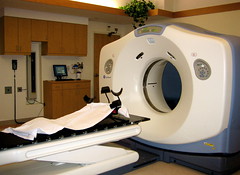A new non-surgical post-mortem technique that has the potential to revolutionise the way autopsies are conducted around the world has been pioneered by forensic pathologists and radiologists at the University of Leicester in collaboration with the University Hospitals of Leicester NHS Trust.
The technique developed by a team in the East Midlands Forensic Pathology Unit, at the University of Leicester, has been published March 1 in International Journal of Legal Medicine. This paper presents the development of the methodology and protocol for this technique from independent research commissioned by the National Institute for Health Research (NIHR).
The study has taken another step towards a minimally invasive autopsy for natural and unnatural deaths, for either single cases or mass fatalities. It could also potentially allay qualms from certain faith groups that object to autopsies.
Professor Guy Rutty, Chief Forensic Pathologist to the East Midlands Forensic Pathology Unit, which is part of the Department of Cancer Studies and Molecular Medicine, University of Leicester, said the pilot study had demonstrated the potential of the technique to change the future of post-mortem procedures.
He said: “Autopsies are not popular with the general public and are viewed with great distaste. There are a number of faith groups who voice objections to the autopsy. The development of a minimally invasive autopsy technique would reduce the overall number of invasive autopsies performed in the UK but would still provide a service to the Coroner and determine the cause of a person’s death. Currently, without the use of angiography, cardiac related death cannot be reliably diagnosed using a post mortem CT (Computed Tomography) scan so we needed to develop a system that could do this.”
“In collaboration with the radiology team, lead by Professor Bruno Morgan, we have successfully developed a quick and simple technique of ‘minimally invasive targeted coronary angiography’ where we inject contrast into the body of a deceased person through a small incision in the neck and then perform a full body CT scan. Using this method we are able to determine the cause of death in up to 80% of cases (in the series analysed to date).









